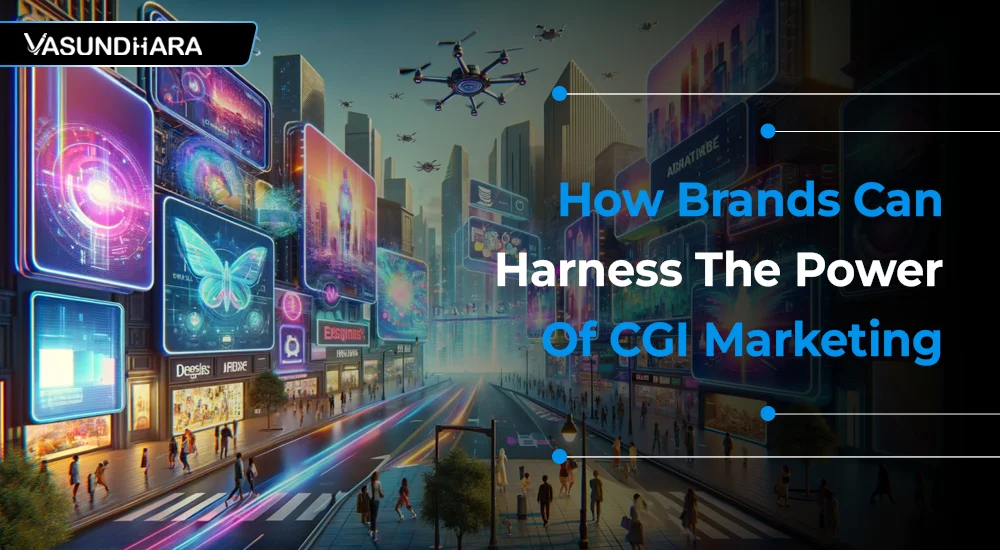How Brands Can Harness The Power Of CGI Marketing


- Jan 24, 2024



Successful marketing strategies are fueled by creativity and innovation.
New and innovative ways to draw in customers are provided by cutting-edge web solutions like computer generated imagery (CGI) technology, which helps businesses stand out in the competitive digital market.
Advances in computer-generated imagery (CGI) have made it possible for brands to produce captivating images and immersive content that connect with their target audience more deeply in recent years.
Through the use of computer generated imagery, movies, 2D/3D animation, and interactive media, companies may present their goods and services in previously unimaginable ways.
The unique benefit of CGI technology is that it can bring a brand's idea to life, going beyond the constraints of conventional marketing to leave a lasting and impactful impression.
In this blog series, we investigate different tactics that brands may use to improve their online presence and go deep into the exciting realm of computer-generated imagery (CGI) in marketing.
The creation of visual content using computers is referred to as CGI.
This method generates lifelike visualizations through the application of 3D modeling, animation, and rendering; the results may range from fantastical worlds to hyper-realistic product renderings.
The versatility of CGI applications in marketing campaigns is remarkable. By enabling marketers to manifest their visions in unprecedented ways, CGI enables everything from product visualization to immersive storytelling.
Photography and videography were frequently utilized in traditional advertising to illustrate products and convey brand narratives.
However, the expanding availability of computer-generated imagery (CGI) has introduced previously exclusive to high-budget productions novel opportunities for innovation.
Presently, brands are employing it to create campaigns that are both aesthetically pleasing and evocative.
Computer-generated imagery (CGI) empowers advertisers to fabricate realistic virtual environments and objects by utilizing digital renders. These renders may depict nonexistent people, places, or objects.
In contrast, it simplifies and reduces the cost of displaying tangible objects in comparison to conventional photography or videography.
CGI serves as a catalyst for redefining the way in which brands interact with their audiences; it is not merely a tool.
One of the primary benefits associated with CGI is its capacity to enable untapped creative potential.
Conventional methods of photography and video production entail considerable financial investment and logistical complexities.
Many of these limitations are eliminated by CGI, enabling marketers to dream big and execute campaigns that were previously considered impracticable.
Contemporary brands are obligated to uphold a uniform visual identity across multiple platforms, and CGI serves as a multipurpose remedy for this problem.
The seamless integration of identical high-quality visuals across various marketing channels, including print, outdoor, social media, and video, is made possible by the dynamic nature of CGI assets.
Computer-generated imagery (CGI) empowers marketers to swiftly adapt to evolving trends and consumer preferences.
When modifying visuals to correspond with a novel campaign motif or revising product attributes, computer generated imagery (CGI) efficiently optimizes the procedure in comparison to conventional, analogue creative methods like photography.
CGI reduces the expense of analog production by a significant margin.
By utilizing photorealistic CGI that is seamless, marketers can circumvent the necessity of producing a physical prototype at an expensive location or studio.
Moreover, this results in an extended time to market, as equivalent campaigns can be executed significantly faster on a computer.
CGI will become increasingly prevalent as software becomes more optimized and computing power becomes more affordable.
To understand the impact of CGI on marketing, let’s explore some real-world examples that showcase the transformative power of this technology.
Not to be outdone, L'Oreal released a fantastic computer-generated image commercial featuring a vintage automobile that seems to be driving around Paris and leaving a red trail from a massive lipstick affixed to its roof.
Over 10 million people viewed this creative blend of brand promotion and product advertising on Instagram.
Its most recent product introduction in London prompted a social media frenzy with the CGI marketing campaign of the international cosmetics brand.
The advertisement featured double-decker buses and underground train carriages with eyelashes rolling into stations where enormous mascara wands applied the product.
This advertisement ignited social media, amassing more than two million likes exclusively on Instagram.
The 'La Bambino' bag video by upscale handbag design studio Jacquemus has recently received considerable attention on Instagram.
The video parodies the brand's renowned micro bags as novelty automobiles traversing the Parisian thoroughfares.
By optimizing smartphone camera angles for 9:16 displays, the campaign's realism and credibility are enhanced in the video
This marketing campaign significantly boosted Nike's revenue.
The campaign featured soccer players and demonstrated the potential repercussions of their future actions. The campaign utilized CGI and achieved sufficient popularity.
This successful campaign once more demonstrated the superiority of Mac computers over their competitors. The animated figures that dominated the campaign were the focal point.
Although we are aware of the advantages of CGI marketing, nothing is flawless. There are a few disadvantages to be aware of prior to making an investment in it.
Every company, no matter how big or little, will use CGI to boost their brand stories when the technology gets cheaper and more widely available.
It is crucial for companies to utilize CGI marketing strategies in a way that aligns with their beliefs.
To successfully engage their customers online and offline, marketers need to strike a balance between CGI and traditional means.
CGI should not replace, but rather enhance, real-world experiences. Clients will remember the dynamic between the two for a long time.
CGI marketing effectively enhances consumer engagement through the provision of visually striking 3D images of products.
Brands around the world are maximizing the effectiveness of this marketing strategy.
While we have already discussed three marketing campaigns, the number of these campaigns is boundless, as they enable businesses to capture visuals that are unattainable using conventional methods.
Although the technology is not widely adopted in India, its potential for innovation and success on the Indian market is immense.
Transform your brand with cutting-edge CGI marketing. Our expert CGI marketing services are tailored to elevate your brand to new heights.
Unlock the potential of CGI with Vasundhara Infotech, top IT company in Surat and watch your brand soar. Let's redefine your online presence together. Contact us today.
Let's bring your brand to life like never before. Request for a quote to unleash the power of CGI.
Copyright © 2025 Vasundhara Infotech. All Rights Reserved.